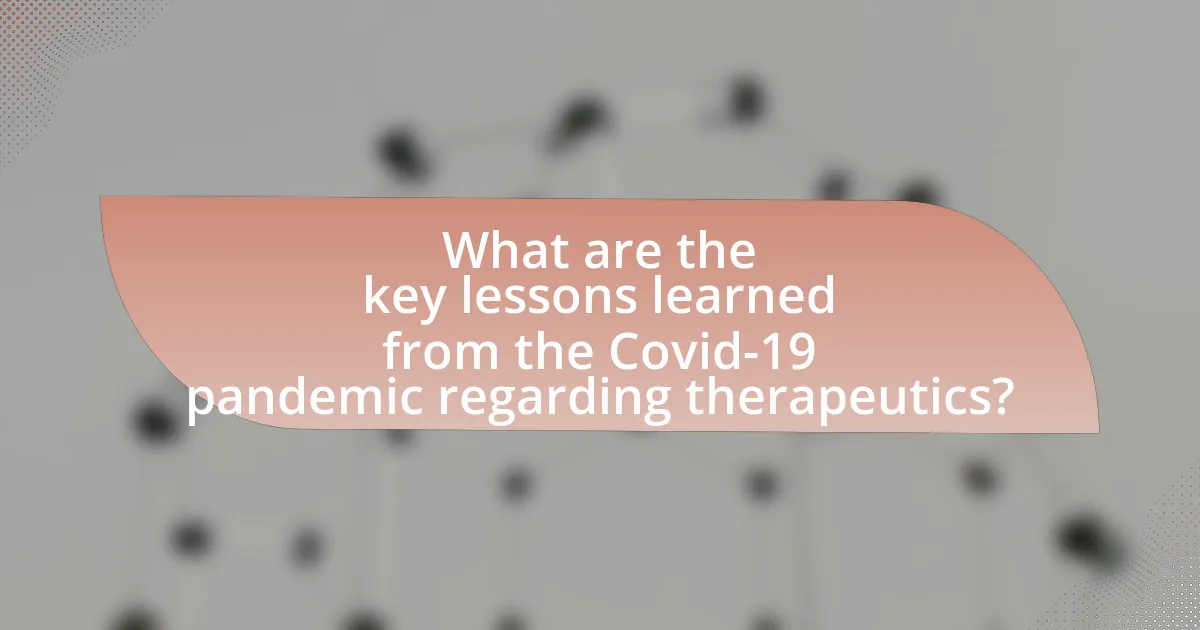The article focuses on the future of Covid-19 therapeutics, highlighting key lessons learned from the pandemic. It discusses the rapid development and deployment of treatments, the importance of global collaboration in research, and the effectiveness of adaptive clinical trial designs. The article also examines initial therapeutic approaches, challenges faced in development, regulatory hurdles, and the impact of supply chain issues. Innovations such as mRNA vaccines and antiviral drugs are explored, along with the role of technology and data analytics in therapeutic advancements. Finally, it emphasizes the need for improved public health policies and strategies to ensure equitable access to therapeutics in future health crises.

What are the key lessons learned from the Covid-19 pandemic regarding therapeutics?
The key lessons learned from the Covid-19 pandemic regarding therapeutics include the importance of rapid development and deployment of treatments, the necessity for global collaboration in research, and the value of adaptive clinical trial designs. Rapid development was exemplified by the swift creation of antiviral drugs and monoclonal antibodies, with treatments like remdesivir receiving emergency use authorization within months of the outbreak. Global collaboration was crucial, as seen in initiatives like the ACT-Accelerator, which aimed to ensure equitable access to diagnostics, therapeutics, and vaccines. Adaptive trial designs allowed for more flexible and efficient testing of multiple therapies simultaneously, leading to quicker identification of effective treatments. These lessons underscore the need for preparedness and innovation in future public health crises.
How did the pandemic shape the development of Covid-19 therapeutics?
The pandemic accelerated the development of Covid-19 therapeutics by fostering unprecedented collaboration among researchers, pharmaceutical companies, and governments. This collaboration led to the rapid identification and testing of potential treatments, exemplified by the emergency use authorizations granted for antiviral drugs like remdesivir and monoclonal antibodies. Additionally, the urgency of the pandemic prompted significant financial investments, with global funding for Covid-19 research exceeding $100 billion, which facilitated faster clinical trials and streamlined regulatory processes. These factors collectively transformed the therapeutic landscape, resulting in a variety of treatment options being developed and deployed in record time.
What were the initial therapeutic approaches taken during the pandemic?
The initial therapeutic approaches taken during the pandemic included the use of antiviral medications, corticosteroids, and monoclonal antibodies. Antiviral medications such as remdesivir were administered to inhibit viral replication, while corticosteroids like dexamethasone were utilized to reduce inflammation in severe cases, as evidenced by the RECOVERY trial which demonstrated a mortality benefit in patients requiring oxygen. Additionally, monoclonal antibodies, such as those developed by Regeneron and Eli Lilly, were employed to neutralize the virus and were shown to reduce hospitalization rates in high-risk patients. These approaches were rapidly adopted based on emerging clinical data and guidelines from health authorities.
How did clinical trials adapt to the urgent need for Covid-19 treatments?
Clinical trials adapted to the urgent need for Covid-19 treatments by implementing accelerated timelines, utilizing adaptive trial designs, and increasing collaboration among stakeholders. Regulatory agencies like the FDA and EMA expedited the approval processes, allowing for faster initiation and modification of trials. For instance, the use of master protocols enabled simultaneous testing of multiple treatments, which significantly reduced the time required to gather data on efficacy and safety. Additionally, the global urgency led to unprecedented partnerships between pharmaceutical companies, governments, and research institutions, facilitating resource sharing and data transparency. These adaptations were crucial in delivering effective treatments and vaccines within a year of the pandemic’s onset.
What challenges were faced in the development of Covid-19 therapeutics?
The development of Covid-19 therapeutics faced significant challenges, including the rapid mutation of the virus, which complicated the efficacy of treatments. Researchers had to adapt quickly to emerging variants, such as Delta and Omicron, which demonstrated resistance to certain therapeutic agents. Additionally, the urgency of the pandemic led to accelerated timelines for clinical trials, raising concerns about the thoroughness of safety and efficacy evaluations. Limited understanding of the virus’s pathophysiology at the onset also hindered the identification of effective therapeutic targets. Furthermore, logistical issues, such as supply chain disruptions and resource allocation, impacted the timely production and distribution of therapeutics. These challenges collectively underscored the complexities involved in developing effective treatments during a global health crisis.
What regulatory hurdles impacted the speed of therapeutic development?
Regulatory hurdles that impacted the speed of therapeutic development include lengthy approval processes, stringent clinical trial requirements, and the need for extensive data on safety and efficacy. These factors often delay the introduction of new therapies, as seen during the COVID-19 pandemic when the urgency for rapid development clashed with traditional regulatory timelines. For instance, the FDA’s Emergency Use Authorization (EUA) process allowed for faster access to treatments, but the overall complexity of regulatory frameworks still posed challenges, leading to delays in some therapeutic approvals.
How did supply chain issues affect the availability of therapeutics?
Supply chain issues significantly reduced the availability of therapeutics during the COVID-19 pandemic. Disruptions in manufacturing, transportation, and distribution led to delays in the production and delivery of essential medications. For instance, a report from the World Health Organization indicated that 90% of countries experienced interruptions in the supply of critical medicines, which directly impacted patient care and treatment outcomes. These challenges highlighted vulnerabilities in global supply chains, emphasizing the need for more resilient systems to ensure consistent access to therapeutics in future health crises.

What innovations emerged in Covid-19 therapeutics during the pandemic?
Innovations in Covid-19 therapeutics during the pandemic included the rapid development of mRNA vaccines, monoclonal antibody treatments, and antiviral medications. The mRNA vaccines, such as those developed by Pfizer-BioNTech and Moderna, demonstrated high efficacy rates exceeding 90% in preventing symptomatic Covid-19. Monoclonal antibodies, like those from Regeneron and Eli Lilly, were authorized for emergency use to treat mild to moderate Covid-19 cases, significantly reducing hospitalization rates. Additionally, antiviral drugs such as remdesivir and the oral antiviral Paxlovid were introduced, showing effectiveness in reducing the severity of the disease and shortening recovery time. These innovations were crucial in managing the pandemic and have set a precedent for future therapeutic developments.
How did technology influence the creation of new therapeutics?
Technology significantly influenced the creation of new therapeutics by enabling rapid drug discovery and development processes. Advanced computational methods, such as artificial intelligence and machine learning, have streamlined the identification of potential drug candidates, allowing researchers to analyze vast datasets and predict molecular interactions more efficiently. For instance, during the COVID-19 pandemic, technologies like high-throughput screening and CRISPR gene editing facilitated the swift evaluation of existing drugs and the development of novel therapeutics, resulting in the emergency use authorization of treatments like remdesivir within months of the virus’s emergence. This technological integration not only accelerated timelines but also enhanced the precision of therapeutic targeting, ultimately leading to more effective treatment options.
What role did telemedicine play in the management of Covid-19 therapeutics?
Telemedicine significantly enhanced the management of Covid-19 therapeutics by facilitating remote consultations and monitoring, thereby reducing the risk of virus transmission. This approach allowed healthcare providers to assess symptoms, prescribe treatments, and manage patient care without requiring in-person visits, which was crucial during lockdowns and social distancing measures. Studies indicated that telemedicine usage surged, with a report from the Centers for Disease Control and Prevention showing a 154% increase in telehealth visits in the early months of the pandemic compared to the previous year. This rapid adoption of telemedicine not only ensured continuity of care for Covid-19 patients but also expanded access to therapeutics, particularly for those in underserved areas.
How did data analytics enhance therapeutic development processes?
Data analytics significantly enhanced therapeutic development processes by enabling more efficient identification of potential drug candidates and optimizing clinical trial designs. By leveraging large datasets, researchers could analyze patient demographics, treatment responses, and disease progression patterns, leading to more targeted and effective therapies. For instance, during the COVID-19 pandemic, data analytics facilitated real-time monitoring of treatment outcomes and adverse effects, allowing for rapid adjustments in therapeutic strategies. This approach not only accelerated the development timeline but also improved the likelihood of successful outcomes, as evidenced by the expedited approval of COVID-19 vaccines and treatments based on data-driven insights.
What new therapeutic classes were introduced for Covid-19 treatment?
New therapeutic classes introduced for Covid-19 treatment include monoclonal antibodies, antiviral agents, and immunomodulators. Monoclonal antibodies, such as bamlanivimab and casirivimab-imdevimab, were developed to target the virus directly and reduce the severity of the disease. Antiviral agents like remdesivir were repurposed to inhibit viral replication, while immunomodulators, including dexamethasone, were utilized to manage the inflammatory response in severe cases. These classes represent significant advancements in the therapeutic landscape for Covid-19, demonstrating the rapid innovation in response to the pandemic.
What are the characteristics of monoclonal antibodies developed for Covid-19?
Monoclonal antibodies developed for Covid-19 are characterized by their specificity, efficacy, and ability to neutralize the virus. These antibodies are engineered to target the spike protein of SARS-CoV-2, which is crucial for the virus’s entry into human cells. For instance, treatments like Bamlanivimab and Casirivimab/Imdevimab have shown significant effectiveness in reducing viral load and preventing severe disease in clinical trials. Additionally, these monoclonal antibodies can be administered via intravenous infusion or subcutaneous injection, providing flexibility in treatment options. Their development has been accelerated through advanced biotechnological methods, allowing for rapid response to emerging variants of the virus.
How do antiviral drugs differ from traditional treatments for Covid-19?
Antiviral drugs differ from traditional treatments for Covid-19 by specifically targeting the virus’s ability to replicate, whereas traditional treatments often focus on alleviating symptoms or managing complications. Antiviral medications, such as remdesivir and molnupiravir, inhibit viral replication directly, which can shorten the duration of illness and reduce the severity of symptoms. In contrast, traditional treatments like corticosteroids primarily reduce inflammation and modulate the immune response, which can help manage severe cases but do not directly affect the virus itself. This distinction is crucial as antiviral drugs can potentially lead to quicker recovery times and lower hospitalization rates, as evidenced by clinical trials demonstrating their efficacy in reducing viral load and improving patient outcomes.

What does the future hold for Covid-19 therapeutics post-pandemic?
The future of Covid-19 therapeutics post-pandemic is likely to focus on the development of more effective antiviral treatments and the integration of these therapies into standard healthcare practices. Research indicates that the pandemic has accelerated the innovation of therapeutics, with a notable increase in the approval of antiviral drugs such as Paxlovid and Molnupiravir, which have shown efficacy in reducing severe outcomes in Covid-19 patients. Furthermore, ongoing studies aim to enhance the understanding of long Covid, leading to targeted therapies that address lingering symptoms. The lessons learned during the pandemic, including the importance of rapid clinical trials and global collaboration, will shape future therapeutic strategies, ensuring preparedness for potential future outbreaks.
How can lessons from the pandemic improve future therapeutic responses?
Lessons from the pandemic can improve future therapeutic responses by emphasizing the importance of rapid vaccine development and adaptive clinical trial designs. The COVID-19 pandemic demonstrated that mRNA vaccine technology could be deployed swiftly, resulting in the Pfizer-BioNTech and Moderna vaccines being developed and authorized for emergency use in under a year, a process that typically takes several years. Additionally, the use of adaptive trial designs allowed researchers to modify ongoing studies based on interim results, leading to more efficient evaluation of therapeutic options. This approach can be applied in future pandemics to accelerate the identification and approval of effective treatments, ultimately enhancing public health responses.
What strategies can be implemented to expedite therapeutic development in future pandemics?
To expedite therapeutic development in future pandemics, strategies such as enhancing global collaboration, utilizing advanced technologies, and establishing rapid regulatory pathways should be implemented. Enhanced global collaboration can facilitate information sharing and resource allocation, as demonstrated during the COVID-19 pandemic when initiatives like the COVAX program enabled equitable access to vaccines and therapeutics. Utilizing advanced technologies, including artificial intelligence and machine learning, can accelerate drug discovery and development processes, evidenced by the rapid identification of potential COVID-19 treatments. Establishing rapid regulatory pathways, similar to the Emergency Use Authorization process employed by the FDA, can streamline approval for promising therapeutics, ensuring timely access to effective treatments during health crises.
How can collaboration between governments and pharmaceutical companies be enhanced?
Collaboration between governments and pharmaceutical companies can be enhanced through the establishment of public-private partnerships that focus on shared goals, such as rapid vaccine development and equitable distribution. These partnerships can streamline regulatory processes, as seen during the COVID-19 pandemic when initiatives like Operation Warp Speed in the United States facilitated faster vaccine approvals by providing funding and resources to pharmaceutical companies. Additionally, governments can create incentives for pharmaceutical companies to prioritize public health needs, ensuring that research and development align with societal demands. This approach not only fosters innovation but also builds trust and transparency between the two entities, ultimately leading to more effective responses to health crises.
What are the implications for public health policy regarding Covid-19 therapeutics?
The implications for public health policy regarding Covid-19 therapeutics include the necessity for rapid approval processes and equitable access to treatments. Public health policies must adapt to ensure that effective therapeutics are available to all populations, particularly vulnerable groups, as evidenced by the disparities in treatment access observed during the pandemic. Additionally, policies should prioritize funding for research and development of new therapeutics, as demonstrated by the accelerated development of antiviral drugs like remdesivir and monoclonal antibodies, which were crucial in managing severe Covid-19 cases. Furthermore, ongoing surveillance and data collection on therapeutic efficacy and safety will be essential to inform future public health strategies and ensure preparedness for potential future outbreaks.
How can equitable access to therapeutics be ensured in future health crises?
Equitable access to therapeutics in future health crises can be ensured through the establishment of global frameworks that prioritize fair distribution, such as the World Health Organization’s COVAX initiative, which aims to provide vaccines and treatments to all countries regardless of income level. This initiative demonstrated that coordinated efforts can lead to more equitable access, as seen during the COVID-19 pandemic when countries with fewer resources were able to receive vaccines through shared mechanisms. Additionally, implementing policies that promote local manufacturing of therapeutics can reduce dependency on high-income countries and ensure that low- and middle-income nations have the capacity to produce essential medicines during crises.
What role will ongoing research play in the evolution of Covid-19 therapeutics?
Ongoing research will be crucial in the evolution of Covid-19 therapeutics by facilitating the development of more effective treatments and vaccines. This research includes clinical trials that assess the efficacy of new antiviral drugs, monoclonal antibodies, and combination therapies, which have shown promise in reducing hospitalization rates and mortality. For instance, studies have demonstrated that antiviral medications like remdesivir and molnupiravir can significantly shorten recovery times in patients with Covid-19. Additionally, ongoing research into the virus’s mutations informs the adaptation of existing therapeutics and the creation of new ones, ensuring they remain effective against emerging variants. This continuous cycle of research and adaptation is essential for maintaining a robust therapeutic arsenal against Covid-19.
What practical steps can be taken to prepare for future pandemics?
To prepare for future pandemics, governments and health organizations should enhance surveillance systems to detect outbreaks early. Effective surveillance has been shown to reduce the spread of infectious diseases; for instance, the Global Health Security Agenda emphasizes the importance of real-time data sharing among nations. Additionally, investing in research and development for vaccines and therapeutics is crucial, as demonstrated by the rapid development of COVID-19 vaccines, which took less than a year due to prior research on coronaviruses. Strengthening healthcare infrastructure, including stockpiling essential medical supplies and ensuring adequate staffing, is also vital; the World Health Organization reported that countries with robust healthcare systems were better equipped to handle COVID-19. Finally, public education campaigns to promote hygiene practices and vaccination can significantly mitigate the impact of future pandemics, as seen in the successful campaigns against measles and influenza.
How can healthcare systems strengthen their therapeutic response capabilities?
Healthcare systems can strengthen their therapeutic response capabilities by enhancing data sharing and collaboration among stakeholders. Improved data sharing enables real-time access to patient information, treatment outcomes, and emerging therapeutic options, which is crucial for timely decision-making. For instance, during the COVID-19 pandemic, the rapid dissemination of clinical trial results and treatment protocols through platforms like the World Health Organization’s COVID-19 database significantly improved therapeutic responses. Additionally, fostering partnerships between public health agencies, research institutions, and private sector entities can facilitate the development and distribution of effective therapeutics, as evidenced by the collaboration between pharmaceutical companies and governments that accelerated vaccine development.
What best practices should be adopted for rapid therapeutic development?
Best practices for rapid therapeutic development include establishing collaborative frameworks among stakeholders, utilizing adaptive trial designs, and leveraging real-time data analytics. Collaborative frameworks, such as public-private partnerships, enhance resource sharing and accelerate innovation, as demonstrated during the COVID-19 pandemic when organizations like Operation Warp Speed facilitated rapid vaccine and therapeutic development. Adaptive trial designs allow for modifications based on interim results, optimizing resource use and expediting the approval process, evidenced by the use of such designs in clinical trials for COVID-19 treatments. Real-time data analytics enable swift decision-making and identification of effective therapies, as seen in the rapid assessment of antiviral drugs during the pandemic. These practices collectively contribute to a more efficient therapeutic development process.


